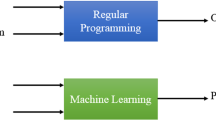Abstract
Pixel art has evolved from a primitive computer image presentation to an independent digital art style. It is widely used on the internet, for graphic user interface (GUI) design, and game industries. Existing pixelation tools and algorithms generate pixel images with artifacts, color clutter, blurring, and a lack of aesthetics. Generally, aesthetics are the dominant concern for pixel art. In this paper, an art-oriented pixelation (AOP) algorithm is proposed to effectively retain the main features of the original image content and the integrity of essential details with the artistic and aesthetic styles. At the same time, the AOP algorithm enables high-quality pixel image generation of arbitrary size without paired datasets and model training effort. The experimental results demonstrate that the pixel image generated by the AOP algorithm outperforms existing algorithms and tools in terms of aesthetics.




























Similar content being viewed by others
References
Qian et al.: Pixel Design-Designers Talk about Pixel Art Creation. Electronic Industry Press (2004)
MacQueen, J., et al.: Some methods for classification and analysis of multivariate observations. In: Proceedings of the 5h Berkeley symposium on mathemati-cal statistics and probability, pp. 281–297 (1967)
Kazuya Saito: PixelMe: Convert your photo into pixelart. https://pixel-me.tokyo/en/ (2020). Accessed 10 Jan 2022
RonenNess: Pixelator. http://pixelatorapp.com/index.html (2021). Accessed 10 Jan 2022
Kabka007: Photoshop quickly converts illustrations to pixel-style. https://www.bilibili.com/video/BV1Tx411q7Wb?share_source=copy_web (2017). Accessed 10 Jan 2022
Allebach, J., Wong, P.W.: Edge-directed interpolation. In: Proceedings of 3rd IEEE International Conference on Image Processing, vol. 3. IEEE (1996)
Carlson, R.E., Fritsch, F.N.: Monotone piecewise bicubic interpolation. SIAM J. Numer. Anal. 22(2), 386–400 (1985)
Shang, Y., Wong, H.-C.: Automatic portrait image pixelization. Comput. Graph. 95, 47–59 (2021)
Zhu, J.-Y., et al.: Unpaired image-to-image translation using cycle-consistent adversarial networks. In: Proceedings of the IEEE International Conference on Computer Vision (2017)
Yi, Z., et al.: Dualgan: unsupervised dual learning for image-to-image translation. In: Proceedings of the IEEE International Conference on Computer Vision (2017)
Kim, T., et al.: Learning to discover cross-domain relations with generative adversarial networks. arXiv preprint arXiv:1703.05192 (2017)
Han, C., et al.: Deep unsupervised pixelization. ACM Trans. Graph. (TOG) 37(6), 1–11 (2018)
Mao, X.: Introduction to OpenCV3 Programming, pp. 248–249. Electronic Industry Press (2015)
One pixel: {Pixel painting teaching}- Modeling 03- manual anti-aliasing. https://www.bilibili.com/video/BV1CE411B7bD?share_source=copy_web (2019). Accessed 10 Jan 2022
Pedro Medeiros: Start drawing pixel paintings. https://indienova.com/indie-game-development/saint11-making-pixel-art-1/ (2020). Accessed 10 Jan 2022
Kopf, J., Shamir, A., Peers, P.: Content-adaptive image downscaling. ACM Trans. Graph. 32(6), 173:1-173:8 (2013)
Öztireli, A.C., Gross, M.: Perceptually based downscaling of images. ACM Trans. Graph 34(4), 1–10 (2015)
Gerstner, T., DeCarlo, D., Alexa, M., Finkelstein, A., Gingold, Y.I., Nealen, A.: Pixelated image abstraction. In: Expressive, pp. 29–36 (2012)
Gerstner, T., DeCarlo, D., Alexa, M., Finkelstein, A., Gingold, Y., Nealen, A.: Pix-elated image abstraction with integrated user constraints. Comput. Graph. 37(5), 333–347 (2013)
Kuang, H., Huang, N., Xu, S., Du, S.: A pixel image generation algorithm based on CycleGAN. In: 2021 IEEE 4th Advanced Information Management, Communicates, Electronic and Automation Control Conference (IMCEC), pp. 476-480 (2021). https://doi.org/10.1109/IMCEC51613.2021.9482118
Acknowledgments
The work is supported by Beijing Dailybread Co., Ltd., and partly supported by the Soft Science Key Research Project of Zhejiang Province (No. 2022C25033).
Author information
Authors and Affiliations
Corresponding author
Ethics declarations
Conflict of interest
The authors declare that they have no known competing financial interests or personal relationships that could have appeared to influence the work reported in this paper.
Additional information
Publisher's Note
Springer Nature remains neutral with regard to jurisdictional claims in published maps and institutional affiliations.
Rights and permissions
Springer Nature or its licensor (e.g. a society or other partner) holds exclusive rights to this article under a publishing agreement with the author(s) or other rightsholder(s); author self-archiving of the accepted manuscript version of this article is solely governed by the terms of such publishing agreement and applicable law.
About this article
Cite this article
Lei, P., Xu, S. & Zhang, S. An art-oriented pixelation method for cartoon images. Vis Comput 40, 27–39 (2024). https://doi.org/10.1007/s00371-022-02763-0
Accepted:
Published:
Issue Date:
DOI: https://doi.org/10.1007/s00371-022-02763-0




